Houdini-Fun
Houdini Normalized Device Coordinates
NDC is a screen space coordinate system, great for perspective illusions and raycasting tricks.
X and Y represent the 2D screen coordinates, while Z represents the distance to the camera.
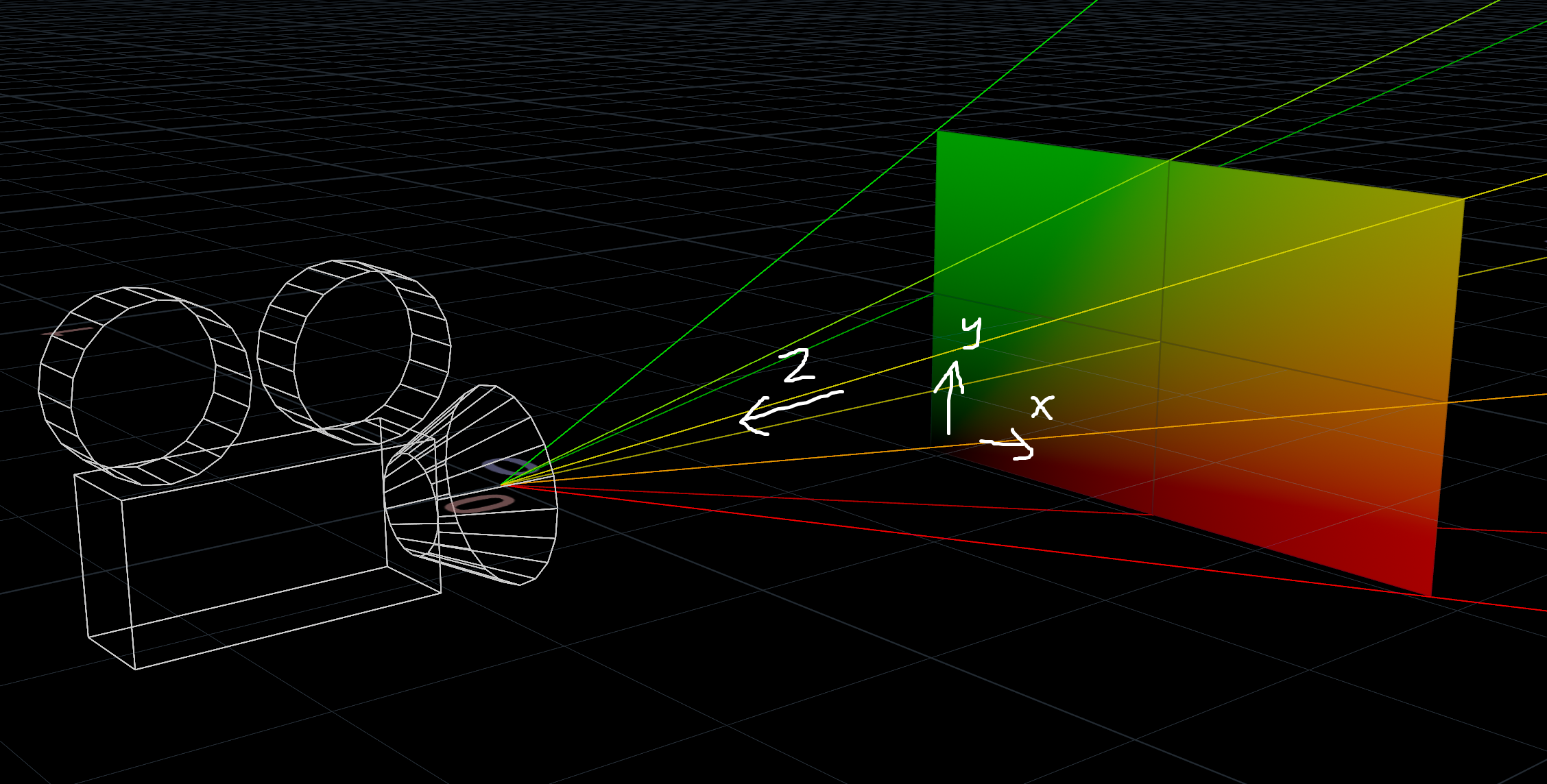
The X and Y coordinates are normalized between 0 and 1, with 0.5 in the middle.
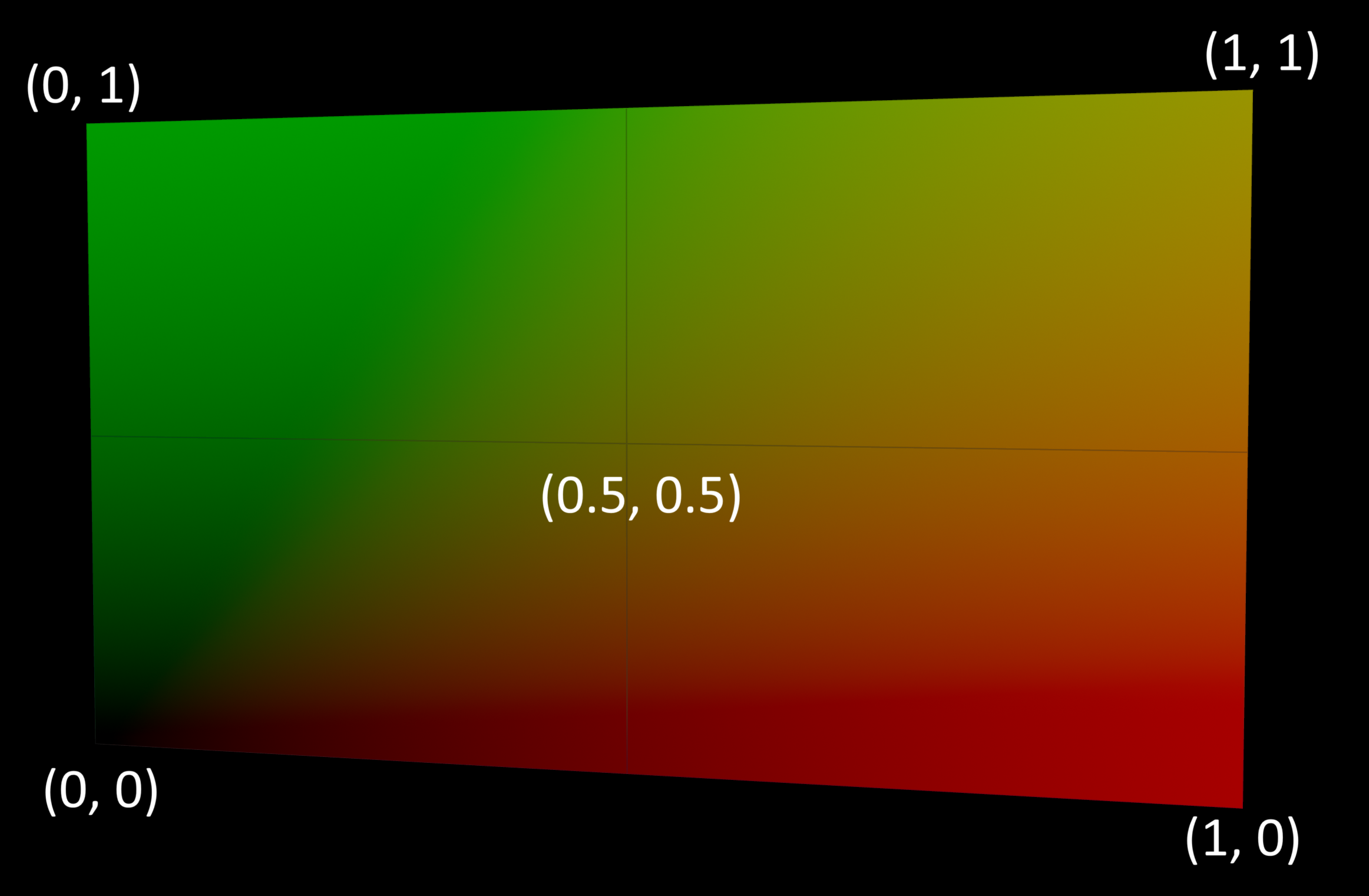
The Z coordinates are 0 at the camera, negative in front and positive behind the camera. Why negative? No idea!

Converting NDC
You can convert a world space coordinate to NDC using toNDC():
vector ndcPos = toNDC(chsop("cam"), v@P);
Then convert it back to world space using fromNDC():
vector worldPos = fromNDC(chsop("cam"), ndcPos);
Here’s some NDC tricks you can play with.
| Download the HIP file! | | — |
Get the camera position
The origin of NDC space is the camera, so just convert {0, 0, 0} to world space.

// Run this in a detail wrangle
string cam = chsop("cam");
vector camPos = fromNDC(cam, {0, 0, 0}); // or {0, 0, 0} * optransform(cam);
addpoint(0, camPos);
{0.5, 0.5, 0} is technically more correct, but gives the same result.
Draw a ray from the camera
The Z axis aligns with the camera direction, so move along it to draw a ray.
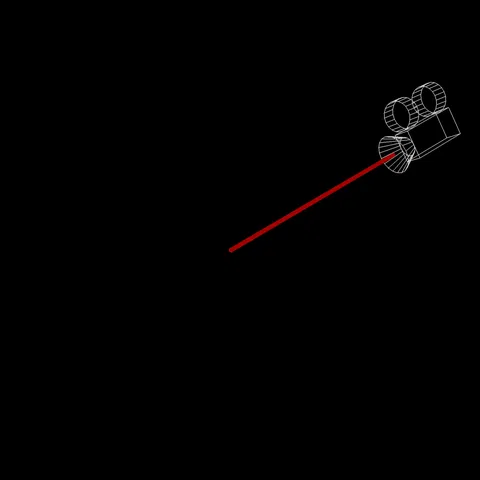
// Run this in a detail wrangle
string cam = chsop("cam");
float offset = chf("raylength");
// Sample two positions along the Z axis in NDC space to draw a ray
vector camPos = fromNDC(cam, {0.5, 0.5, 0});
vector camPos2 = fromNDC(cam, set(0.5, 0.5, -offset));
int a = addpoint(0, camPos);
int b = addpoint(0, camPos2);
addprim(0, "polyline", a, b);
Flatten to the XY plane
Using NDC coordinates directly in world space flattens the geometry to how it looks on screen, like a printed photo.
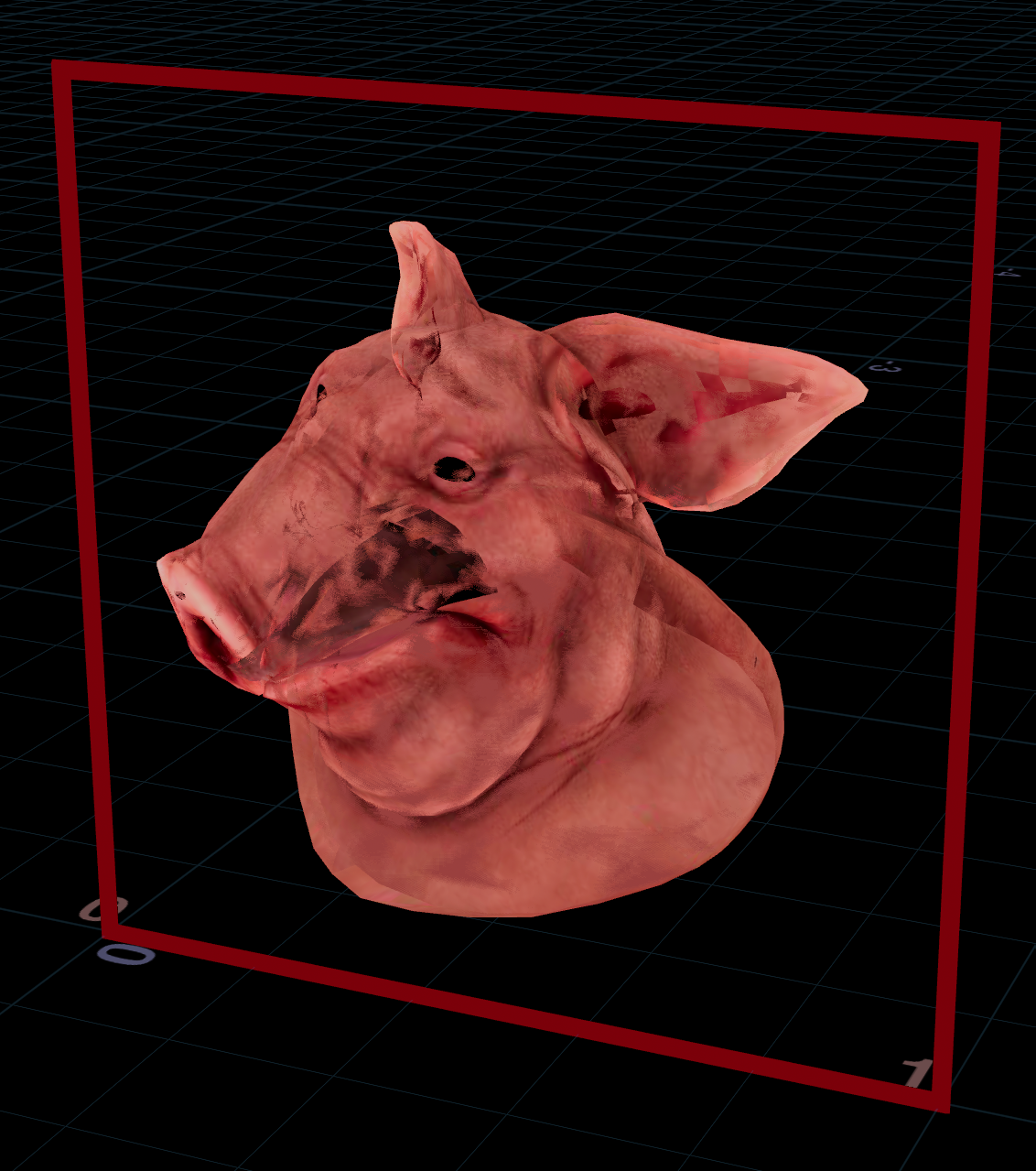
string cam = chsop("cam");
// Flatten by setting Z to a constant value
v@P = toNDC(cam, v@P);
v@P.z = 0;
Another trick is turning this into an outline, much like Labs Extract Silouette.
- Add a Triangulate2D node. Set “Silhouette” to
*and enable outside removal. This triangulates the mesh.
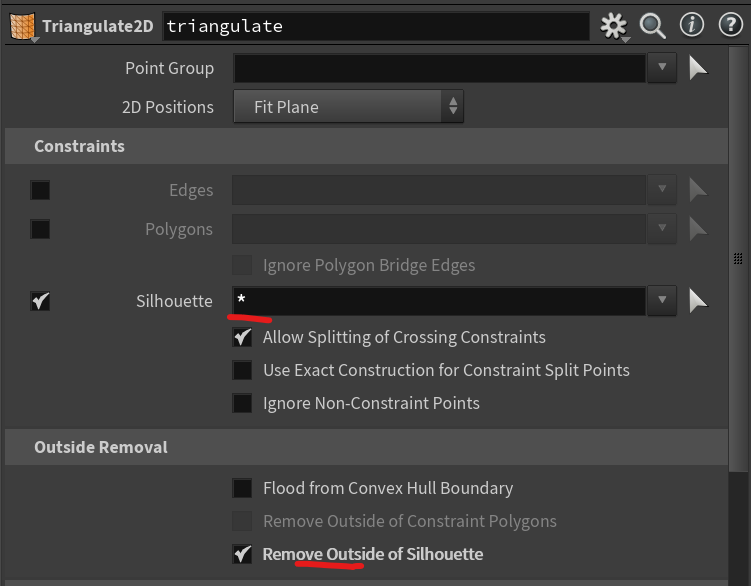 |
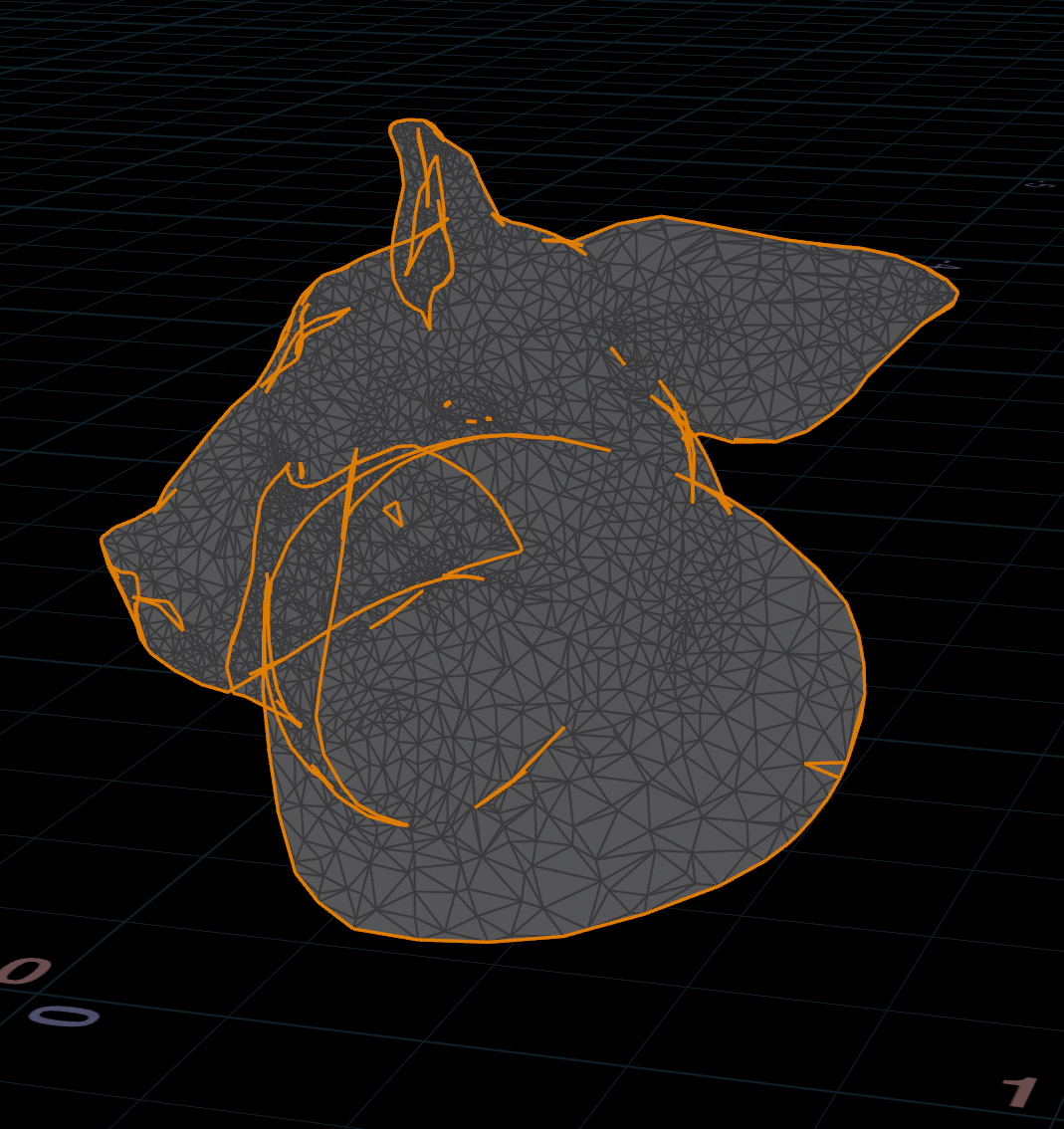 |
- Add a Divide node set to “Remove Shared Edges”. This wipes the interior triangles and produces a clean outline.
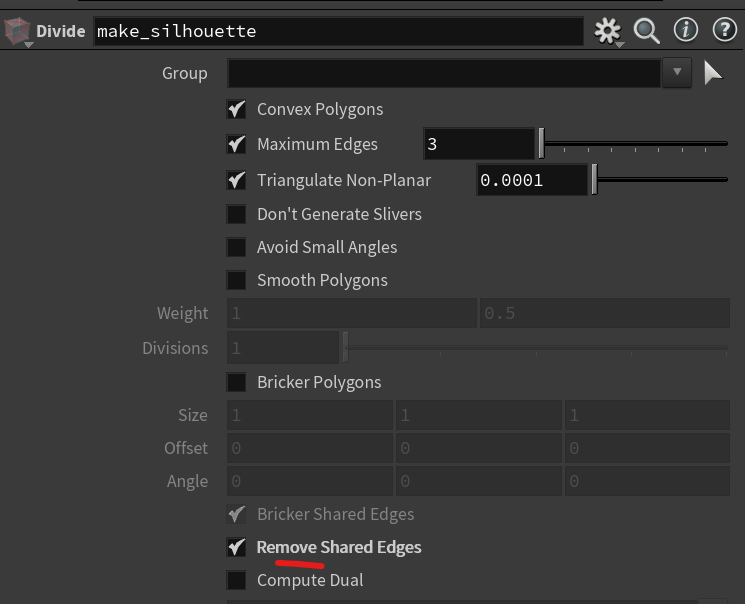 |
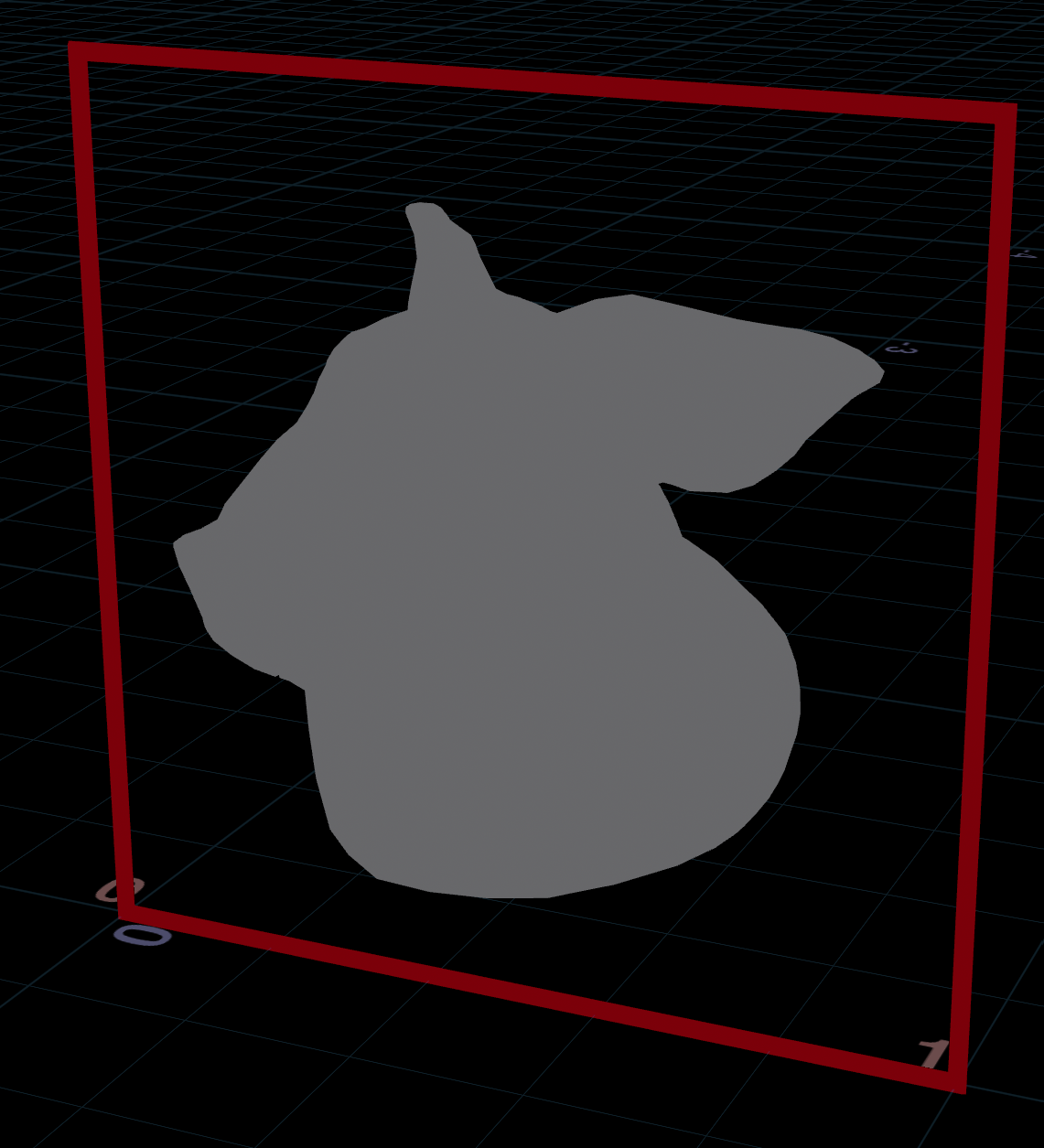 |
Flatten to the camera plane
Using NDC coordinates in camera space lets you flatten geometry but keep it identical from the camera perspective.
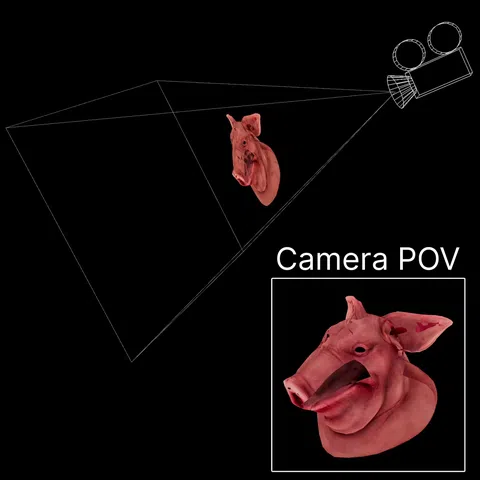
string cam = chsop("cam");
float offset = ch("distance");
// Flatten to camera by setting Z to a constant value
vector p = toNDC(cam, v@P);
p.z = -offset;
v@P = fromNDC(cam, p);
Move along the Z axis
Same as above, except subtracting the Z coordinate. Again the geometry is identical from the camera perspective.

string cam = chsop("cam");
float offset = ch("distance");
// Distort relative to camera by adding or multiplying the Z value
vector p = toNDC(cam, v@P);
p.z -= offset;
v@P = fromNDC(cam, p);
Perspective illusion
Same as above, except using another camera as reference. The Z coordinates are flipped as the cameras cross paths.
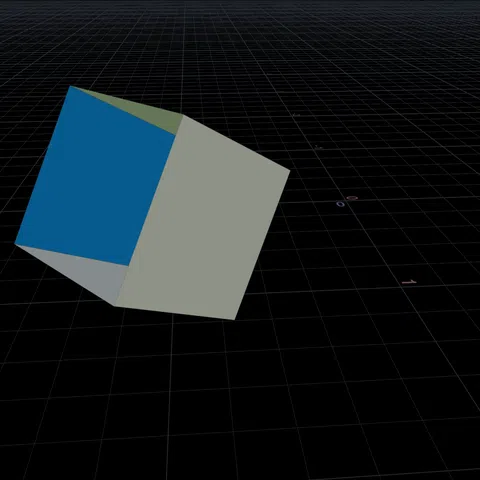
string cam = chsop("cam");
float mult = ch("multiply");
float add = ch("add");
// Distort relative to camera by adding or multiplying the Z value
vector p = toNDC(cam, v@P);
p.z = p.z * mult + add;
v@P = fromNDC(cam, p);
Frustum box
The VEX equivalent of Camera Frustum qL.
- Add a box. The X and Y coordinates range from 0 to 1. The Z coordinates are negative from 0 to the depth you want.
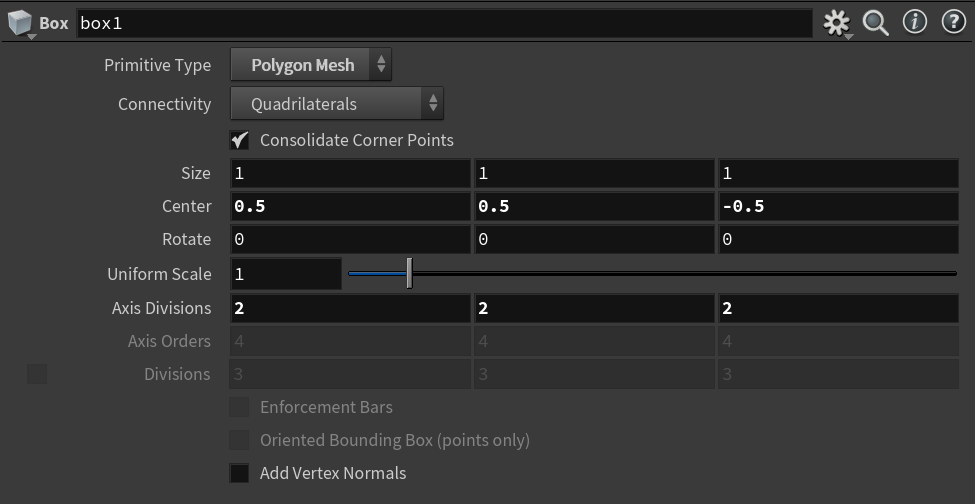 |
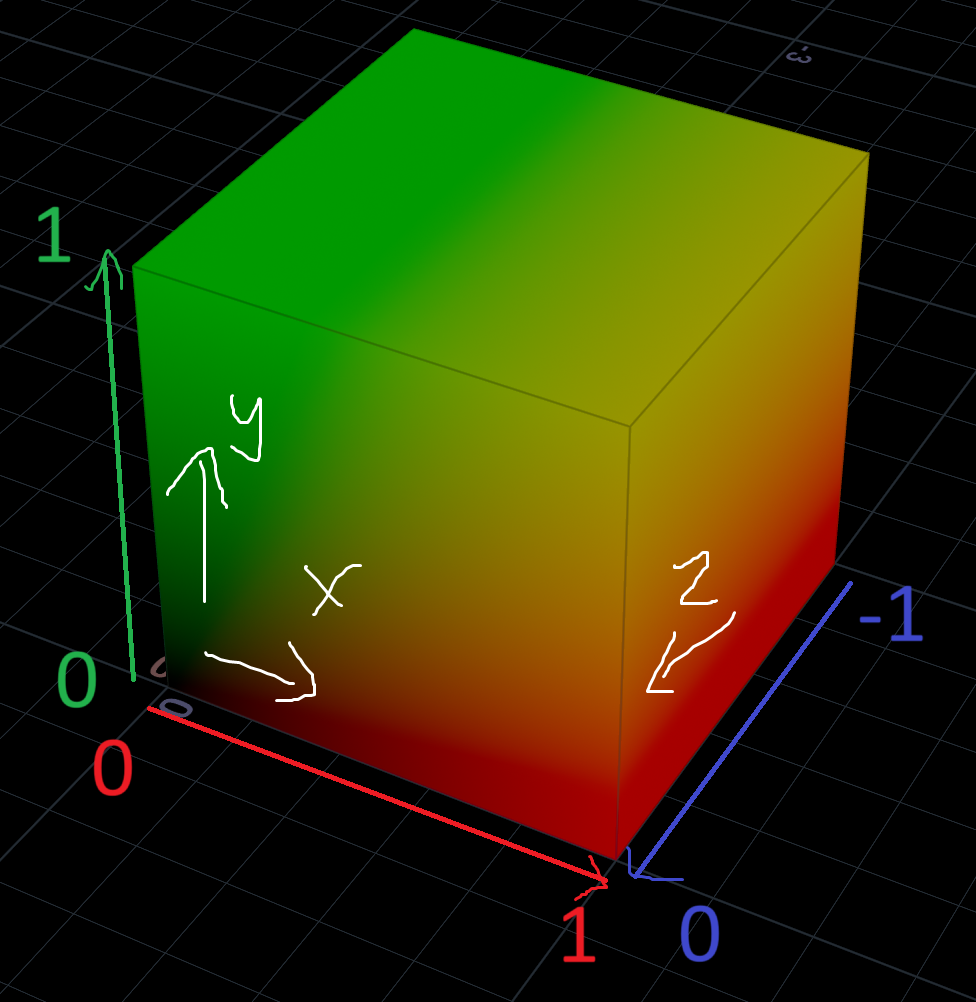 |
- Convert from NDC to world coordinates.
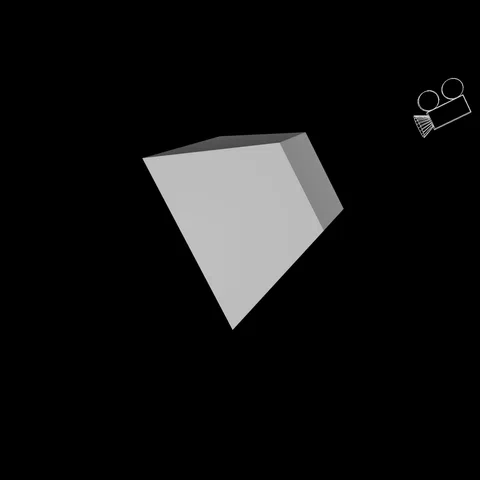
string cam = chsop("cam");
// Optionally animate it along the Z axis
v@P.z -= chf("distance");
v@P = fromNDC(cam, v@P);
Frustum plane
The VEX equivalent of Camera Plane qL.
- Same as above, but add a grid instead. The X and Y coordinates range from 0 to 1.
 |
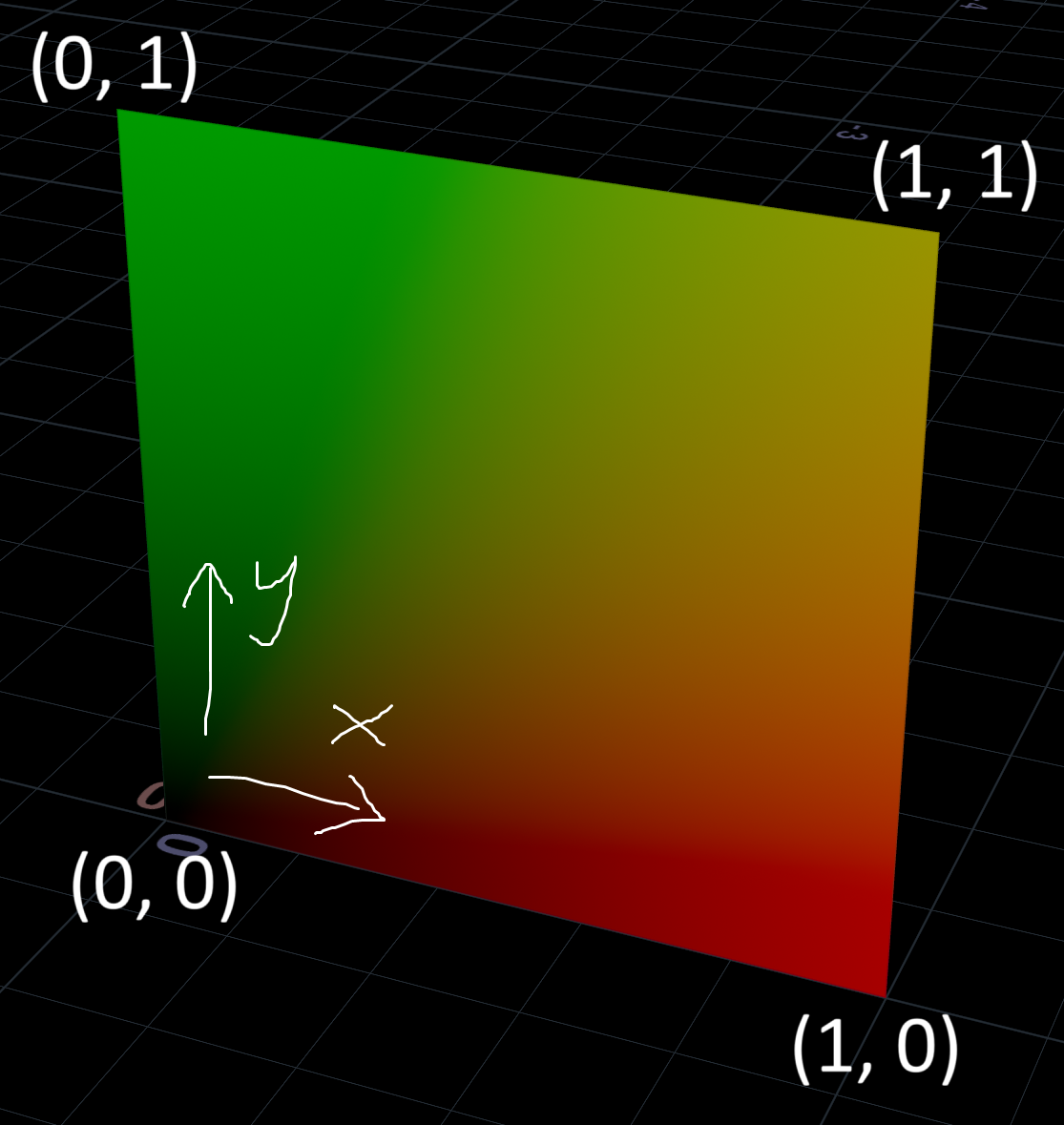 |
- Convert from NDC to world coordinates.
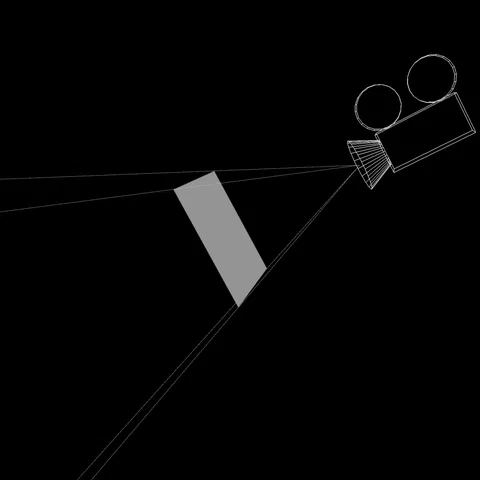
string cam = chsop("cam");
// Optionally animate it along the Z axis
v@P.z = -chf("distance");
v@P = fromNDC(cam, v@P);
Project onto geometry
This technique is great for holograms. I first saw Entagma use it for a raytracer.
- Take the frustum plane above and subdivide it a bunch.
- Find the projection direction per point.
Since the plane is flattened on Z in NDC space, this is easy. Just subtract the camera position from the current position.
string cam = chsop("cam");
vector camPos = fromNDC(cam, {0, 0, 0});
// Projection direction
v@N = normalize(v@P - camPos);

- Ray onto the target geometry.
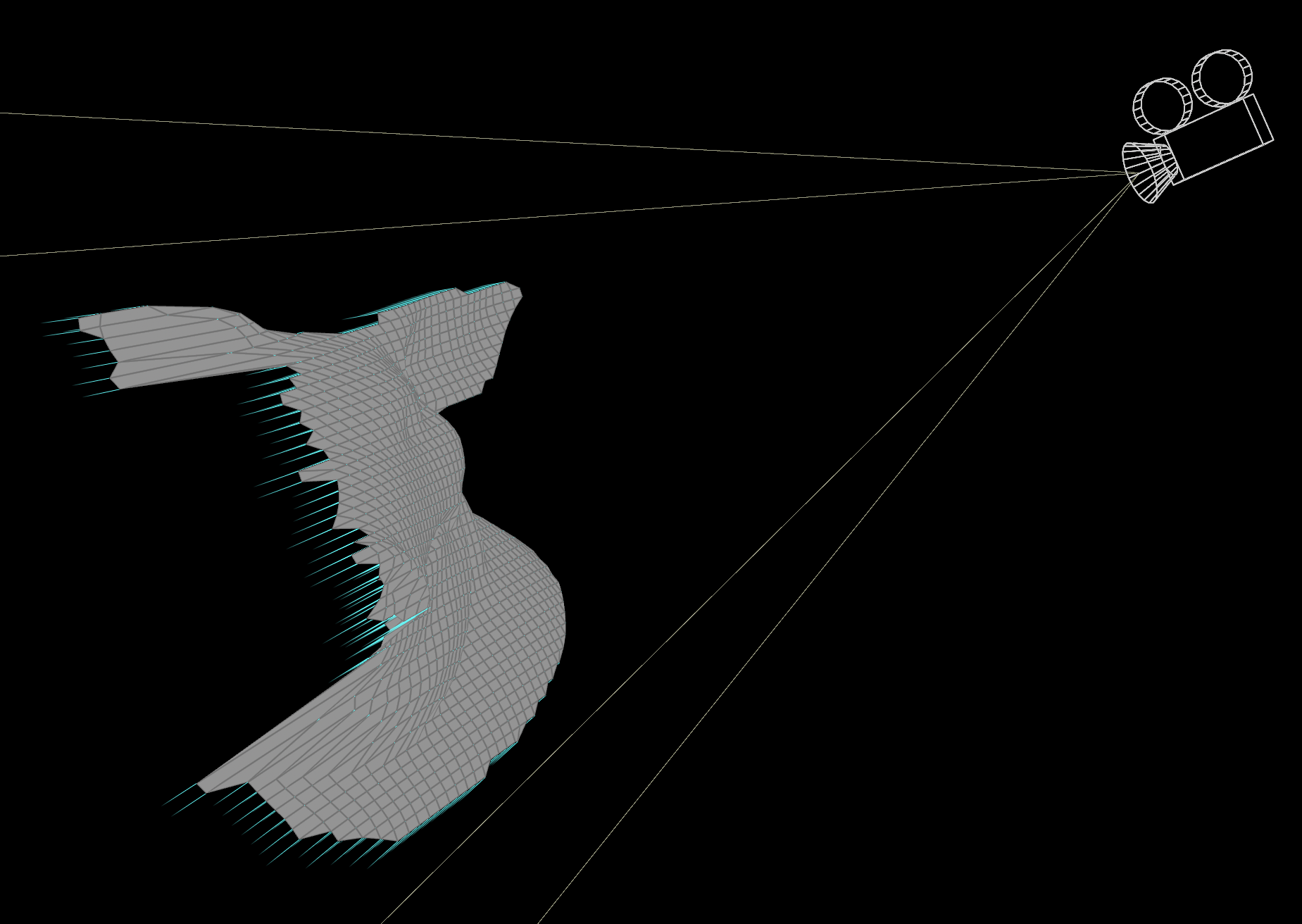
For arbitrary geometry, the same idea applies. Convert to NDC space, flatten Z and convert back to world space.
string cam = chsop("cam");
vector camPos = fromNDC(cam, {0, 0, 0});
// Flatten Z axis in NDC space
vector ndcPos = toNDC(cam, v@P);
ndcPos.z = -1;
vector worldPos = fromNDC(cam, ndcPos);
// Projection direction
v@N = normalize(worldPos - camPos);
Project depth maps
Assuming no distortion, depth maps are easy to project using NDC coordinates.
You can get a depth map from Copernicus using Rasterize Geometry with intrinsic:depth_eye.

To project into world space, just set the Z coordinate to the color of the texture. @depth came from Attribute From Map.

string cam = chsop("cam");
v@P.z = -f@depth - chf("offset");
v@P = fromNDC(cam, v@P);
Cull offscreen geometry
Perhaps the most common use of NDC space is removing offscreen geometry.
So what is offscreen? For X and Y it’s anything outside the 0 to 1 range, and for Z it’s anything positive.
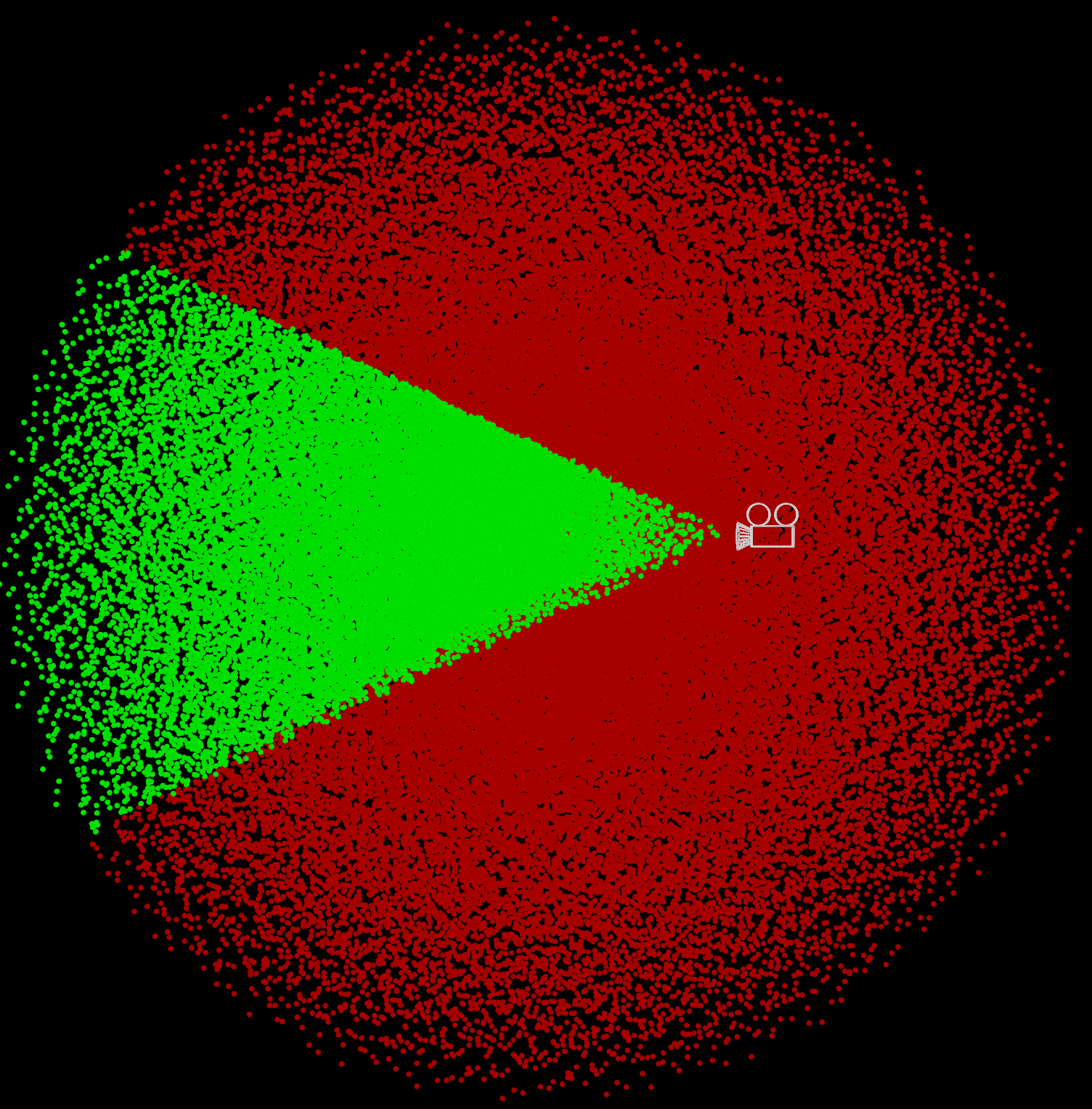
string cam = chsop("cam");
vector ndcPos = toNDC(cam, v@P);
if (ndcPos.x < 0 || ndcPos.x > 1 // Remove outside 0-1 on X
|| ndcPos.y < 0 || ndcPos.y > 1 // Remove outside 0-1 on Y
|| ndcPos.z >= 0) { // Remove behind camera (positive Z)
removepoint(0, i@ptnum);
}
It helps to add some wiggle room near the edges to avoid issues like glitchy motion blur or flickering shadows.

float padding = chf("padding");
string cam = chsop("cam");
vector ndcPos = toNDC(cam, v@P);
if (ndcPos.x < -padding || ndcPos.x > 1 + padding // Remove outside 0-1 on X (with padding)
|| ndcPos.y < -padding || ndcPos.y > 1 + padding // Remove outside 0-1 on Y (with padding)
|| ndcPos.z >= 0) { // Remove behind camera (positive Z)
removepoint(0, i@ptnum);
}
Cull geometry facing away from camera
You can measure the correlation between the camera direction and object normal using dot(v@N, camDir).
Using this as the Clip attribute, you clear any geometry facing away from the camera.

string cam = chsop("cam");
// dot() finds correlation between the normal direction and camera direction
vector camPos = fromNDC(cam, {0, 0, 0});
vector camDir = normalize(camPos - v@P);
// Use this attribute with Clip
f@correlation = dot(v@N, camDir);
Build your own NDC matrix
You can use perspective() to build a matrix that has the same effect as toNDC() (assuming the camera is in perspective mode).
Thanks to Igor Elovikov for sharing the code below! He noted this:
VEX
toNDC()feels a bit misleading and confusing.
Usually NDC space is a cube from (-1, 1, 1) to (1, 1, 1), but VEX transforms it to screen space and removes normalization from Z.
So X, Y is normalized but Z is the actual Z, the distance from the camera.
Also when you’re doing stuff manually, you should work with homogenous coordinates (vector4 basically).
string cam = chsop("cam");
4@projection = perspective(
chf(cam + "/focal") / chf(cam + "/aperture"),
chf(cam + "/resx") / chf(cam + "/resy"),
chf(cam + "/aspect"),
0, 1,
{-1, -1, 1, 1}
);
4@world_to_camera = invert(optransform(cam)); // or getspace("space:world", cam);
4@to_ndc = 4@world_to_camera * 4@projection;
// Equivalent to v@P = toNDC(cam, v@P);
vector4 pos = vector4(v@P) * 4@to_ndc;
v@P = vector(pos) / pos.w;
v@P.z = pos.z;
Try this version if you want Z to be normalized:
string cam = chsop("cam");
4@projection = perspective(
chf(cam + "/focal") / chf(cam + "/aperture"),
chf(cam + "/resx") / chf(cam + "/resy"),
chf(cam + "/aspect"),
chf(cam + "/near"),
chf(cam + "/far")
);
4@world_to_camera = invert(optransform(cam)); // or getspace("space:world", cam);
4@to_ndc = 4@world_to_camera * 4@projection;
v@P *= 4@to_ndc;
Convert both ways
Igor also shared how to calculate fromNDC() based on a modified version of toNDC().
Inverse transform is tricky as it involves the inversion of what I did before (denormalization of Z)
Also you have to keep the W component of the point
Actually I saw somewhere there should be an implicit 4th component, but not sure.
toNDC()
string cam = chsop("cam");
f@near = chf(cam + "/near");
f@far = chf(cam + "/far");
4@projection = perspective(
chf(cam + "/focal") / chf(cam + "/aperture"),
chf(cam + "/resx") / chf(cam + "/resy"),
chf(cam + "/aspect"),
f@near,
f@far,
{-1, -1, 1, 1}
);
4@world_to_camera = invert(optransform(cam)); // or getspace("space:world", cam);
4@to_ndc = 4@world_to_camera * 4@projection;
float clip_z = f@far - f@near;
// Equivalent to v@P = toNDC(cam, v@P);
vector4 pos = vector4(v@P) * 4@to_ndc;
v@P = vector(pos) / pos.w;
v@P.z = f@near + pos.z * clip_z;
f@origin_w = pos.w;
fromNDC()
vector4 pos = v@P;
pos.z = invlerp(v@P.z, f@near, f@far) / f@origin_w;
pos *= invert(4@to_ndc);
v@P = vector(pos) / pos.w;